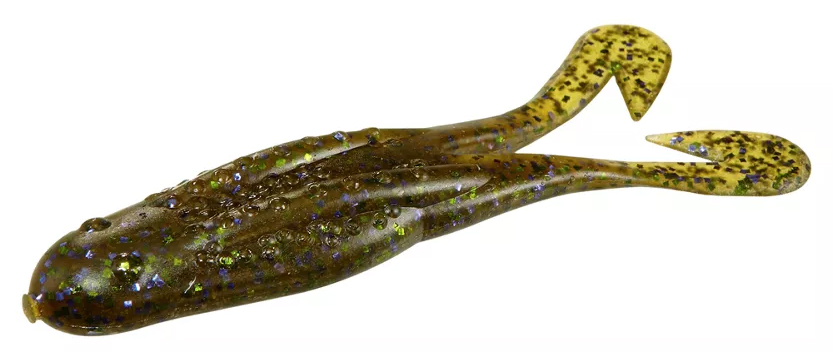Froggin’ the Lily Pads

By Dennis Doyle
I cast my line out into the tangled spread of floating, crowded lily pads and let the lure sit. After a long minute I give the surface frog just a twitch and pause. A few feet from the lure I notice some pads moving as something below eases through. Twitching the frog, I start it toward an open path in the thick surface blossoms and pause once more. Then the water explodes underneath.
Waiting until I feel the weight of the fish, my line tightens and I rip back hard to drive the big bass hook past the frog’s body and into the largemouth’s jaw. Stung, the fish comes out of the water, high and sideways, landing violently in the midst of a dense lily pad tangle, pulling deep.
With my stout rod bent to the corks, I use the fish’s resistant mass to winch my canoe further into the pads, ever closer to the struggling beast. By the time I finally get to the devil it’s locked up solid below in the denseness of the vegetation. Cautiously sorting through the stalks, I finally got a glimpse of my frog; it was shiny with fish slime but all alone. Somehow the bass had given me the slip.
My heart was still thumping with energy as I sorted through the mess, reset the hook, and prepared another cast. I wasn’t sad at losing this round—frog fishing is like that. Lots of excitement, lots of disappointment, but plenty of action. What’s not to like?
I still remember my very first experience with frog fishing, many years ago. I had been fly-rodding around the lily pads for bluegills with small poppers and had fouled someone’s old line. Pulling it into my canoe, I discovered it still had the lure attached, a soft plastic dark green horny toad, the first I had ever seen.
Curious, since I also had a 6-foot, light spin rod along, I put the horny toad on its 6-pound line and cast it toward the edge of the pads. BLAM: a big bass immediately attacked it. But luckily, due to my lightning fast reflexes, I pulled the frog right out of its jaws.
Thoroughly shaken, I moved a bit away into the next area of pads and tried again.
This time I waited until the bass began to swim off with the lure before I hit it. The fish surged away, hardly noticing the new resistance, though my rod was bent. When it did finally notice, it just spit out the frog and swam off. I just didn’t have enough rod butt nor line strength to set that big hook.
But that didn’t deter me. Entranced by the bucketmouths’ eager appetite for the frog, I kept at it with surprisingly consistent results. The seventh bass was the charm, as the hook somehow took hold on this one and the fish was too small to smash my gear. I finally got one to the boat for release.
However, now my lucky frog was worn and torn to a frazzle and there was scarcely anything solid to hold the hook, so I went back to merrily popping for the bluegills. But I did not forget that experience.
The next weekend, armed with a stout casting rod and reel, 30-pound braid, a dozen fresh horny toads plus some floating surface frogs (horny toads are sub-surface) in various colors and with assorted models of frog hooks, I returned to the scene of my original crime.
I was soon to discover that big pickerel liked them as much as the bass though they were much harder on the baits. After a couple of hours of tearing up the lilies and the fish, and with sore wrists and a rapidly dwindling lure supply, I conceded a unilateral—but only temporary—ceasefire.
With many more fish lost than boated, I still felt like it was an outstanding victory on my part. If you boat all of them, it’s hardly a sport. I had discovered an amazingly exciting way to tangle with the big locals. Areas I’d previously considered unfishable were suddenly prime habitat and I had another way to spend my days and my lure money. All in all, it was an excellent experience, definitely worth trying if you’re so inclined.
